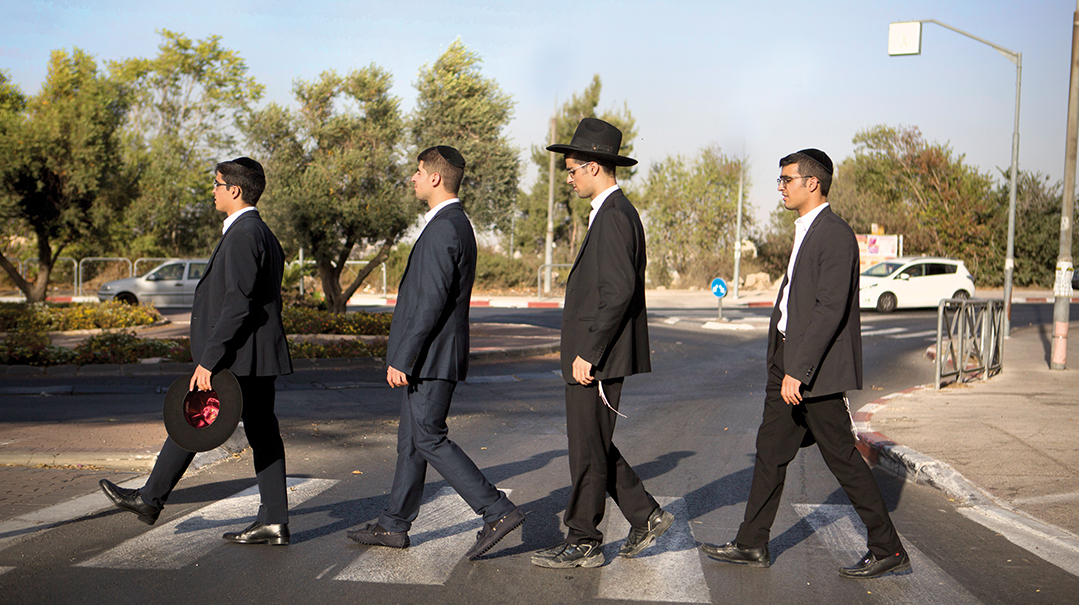Four by Four


BROTHERS FOUR What’s it like to grow up as a quad? You can ask Yishai Shlomo Bentzi and Yosef just about anything but that question: “How do we know? We don’t know any other reality” (Photos: Lior Mizrachi)
I
t was the day after Succos eighteen years ago and the Har Nof shul in Jerusalem was packed to capacity.
It seemed as if the whole neighborhood had come to celebrate the unusual sequence of brissim that were about to take place.
The family had been advised to make sure each bris milah was its own affair, and so the ceremony commenced with the bris of bechor Bentzion. When it was over, he was taken to the Mother and Baby Convalescent Home in Telshe Stone, while the guests enjoyed their first seudah of the day. An hour later, baby Yosef was ushered in, had his bris, and was taken to Telshe Stone. That seudah was followed an hour later by baby Shlomo’s bris, and then finally the youngest, Yishai, had his turn in the limelight.
Of course, it wasn’t the first set of quadruplets to be born in Israel, but a young reporter for Israel Television had interviewed beaming new mom Yael Mizrachi from the maternity ward at Shaare Zedek Medical Center, and the Mizrachi quads became instant national celebrities.
They were in the news again recently when Yael — who maintains a network of influence among nonreligious women and struggling, overwhelmed mothers — posted a message for her many contacts on social media in honor of her sons’ 18th birthday: “I remember when they were born, a lot of media people came to cover this amazing miracle, and one photographer smiled and said, ‘Wow, four Golani soldiers!’ At the time, I said to myself, ‘Well, I have 18 years to give an answer,’ and today, baruch Hashem, my sons are all fighting for our country, but on a different front. They’re all learning in yeshivot, doing their share for kiyum olam with their tireless spiritual endeavors.”
I Won the Lottery
The quads were an unexpected bonus for the Mizrachis — it was a second marriage for both of them, following painful, challenging years. Yael had three children from her first marriage, the oldest just in first grade. Rav Yechezkel, a cheder rebbi, had previously been married for 17 years without children. At a certain point, he made peace with the possibility that he’d never have a child of his own.
“Can you believe it?” Yael says, “Less than a year after we were married, he had to think of names for four boys.” A few years later they were blessed with another set of twins and two more “singles.” And they managed to raise all 11 children — nine boys and two girls — in a two-bedroom apartment. How did that work? “Well,” says Yael, who remembers how she “felt she’d won the lottery” when she heard how many babies she was carrying, “each child got his own floor tile.”
The quads were home from their various yeshivos to celebrate their 18th birthday together, and we were also invited to the “party.” Yishai had just come home from Afula up north; Shlomo, from Tifrach in the south; Bentzi, from Yeshivas Chevron, a local bus ride away; and Yosef, also from a yeshivah in Jerusalem.
“Please,” Bentzi warns, “just don’t ask us what’s it’s like to be one of quadruplets! Sorry, but it’s a pretty dumb question — how are we supposed to know what it’s like? For us, this is normal. We don’t know any other reality.”
Oops! We could not locate your form.







